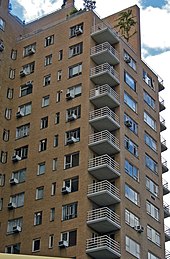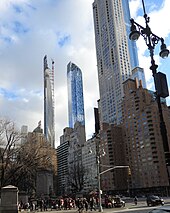240 Central Park South
[9] In the late 19th and early 20th centuries, Central Park South was developed as Manhattan's "Gold Coast", with many prestigious hotels and apartment buildings being erected on its route.[10][11] The site of 240 Central Park South was previously owned by George Ehret, a brewer who had become one of New York City's largest real estate owners by the 1920s, behind only the Astor family.[15] Shortly afterward, Ehret's lot and the neighboring Engine Company 23 firehouse on 233 West 58th Street were developed, with a two-story building being erected on the site to cater to the area's automobile industry.[23] Various contractors were hired for the windows, materials, elevators, floor and wall coverings, furnishings, hardware, electrical installation, plumbing, and heating and air conditioning.[5][38] The western (right) side of the courtyard has a gray-blue terracotta wall of square tiles made by the Atlantic Terra Cotta Company, which encloses a single-story storefront.[17][28] On the northern facade, above the center three windows on the second and third story, are two abstract mosaic panels, which comprise "The Quiet City", a mural by Amédée Ozenfant.The northern lobby contains green terrazzo flooring, copper-clad walls, recessed lighting, and a marble mail desk.[30][49] The lobby contains doors to the storefronts facing Broadway and Columbus Circle, as well as a restaurant space on the northeastern corner of the building at Central Park South.[49] 240 Central Park South's open spaces include the small courtyard at the main entrance, plantings along 58th Street, the enclosed conservatory at ground level, and rooftop gardens and terraces atop various parts of the building.On the roof of the lobby between the two apartment blocks, a garden with willows, forsythia, rhododendrons, and grass plots with flower beds was planted.Additionally, the basement had rooms for work, storage, and laundry, while the 20th floor of the northern apartment block had a solarium and recreation area.[21][53] By the 1930s, Mayer and Whittlesey were formulating plans for an apartment building combining an urban setting with suburban features such as green space.[54] 240 Central Park South Inc., a subsidiary of J. H. Taylor Management, bought the Ehret site that May, with plans to erect a $4.5 million development there.The architects wanted the building to be profitable, modern in design, and socially desirable,[26] while also maximizing the number of apartments with views of Central Park.[14][46] Leasing started in March 1940,[23] and J. H. Taylor Management commenced a marketing campaign with mailers and newspaper advertisements to attract people looking for a suburban ambience.[56] Potential tenants were carefully selected by Tobias's team, and the entire tenth floor was furnished to demonstrate the variety of apartments available.[64] Samuel Solomon, a gangster better known as Sam Boston, was arrested at his home inside the building in 1943, and was charged and convicted of running an illegal gambling ring at his residence.[66][67] In the late 20th century, actors Sylvia Miles, Angie Harmon, and Lou Jacobi also took up residence at 240 Central Park South.[72] By the first decade of the 21st century, the building was in disrepair; the facade bricks were in mismatched colors, while the courtyard had "shattered tiles and dry fountains", according to The New York Times.A group of preservationists, led by New York state senator Thomas Duane, started to advocate for official city landmark protection in 2001, with the commencement of major renovations at the building.[79][80][81] The same year, architecture critic Lewis Mumford wrote for The New Yorker that 240 Central Park South was "a real success" and expressed admiration for the building's form, facade, balconies, windows, Broadway storefronts, and main entrance.[79][85] Paul Goldberger wrote in 1977 that 240 Central Park South, while "often overlooked", had apartments that were "well organized and a far cry from the cramped layouts" of that era.[29] Goldberger also called the building "a remarkably sophisticated design" for its time, with its varied apartment layouts, Broadway storefronts, and park views.[87] Martin Filler, writing for The New Republic in 2000, described 240 Central Park South as Columbus Circle's best structure, saying: "This stylish exemplar of high-density urbanism, completed just before civilian construction halted with our entry into World War II, has never been superseded.





Art DecoModerneCoordinatesAlbert MayerJulian WhittleseyU.S. National Register of Historic PlacesNew York State Register of Historic PlacesNew York City LandmarkManhattanMidtown ManhattanNew York CityCentral ParkColumbus CircleBroadway58th Streetland lotCentral Park SouthfacadeMichelin-starredAmédée OzenfantLewis MumfordArchitectural ForumNew York City Landmarks Preservation CommissionNational Register of Historic PlacesGainsborough Studios220 Central Park South2 Columbus CircleDeutsche Bank CenterTrump International Hotel and TowerCentral Park Tower1790 BroadwayNew York City Subway59th Street–Columbus Circle stationAstor familyTimes SquaresetbacksAmerican bondwindow sillscasement windowspavilionAtlantic Terra Cotta CompanyBethlehem Steelfloor areaterrazzorooftop gardenscrabapplesmagnoliawhite birchBoston ivywillowsforsythiarhododendronssoffits5 Columbus CircleNew York Herald TribuneAmsterdamStockholmViennaFanny FarmerHelen JepsonAntoine de Saint-ExupérySylvia MilesAngie HarmonLou JacobiLois LaneSupermanA Face in the Crowd111 West 57th Street200 Central Park SouthThomas DuaneNew York City designated landmarkNew York Landmarks ConservancyGreat DepressionMuseum of Modern ArtPaul GoldbergerRobert A. M. SternThe New RepublicArt Deco architecture of New York CityList of New York City Designated Landmarks in Manhattan from 14th to 59th StreetsNational Register of Historic Places listings in Manhattan from 14th to 59th StreetsNational Park ServiceNew York City Department of City PlanningNew York State Office of Parks, Recreation and Historic PreservationNew York City Department of Information Technology and TelecommunicationsProQuestmta.infoMetropolitan Transportation AuthorityWhite, NorvalAIA Guide to New York CityMidtown (42nd–59th Streets)1 Worldwide Plz2 Columbus Cir5 Columbus Cir5 W 54th St7 W 54th St10 W 56th St11 W 54th St12 W 56th St13–15 W 54th St30 W 44th St (Penn Club)30 W 56th St46 W 55th St111 W 57th St120 W 46th St125 W 55th St130 W 57th St140 W 57th St165 W 57th St200 Central Park S218 W 57th St220 Central Park S224 W 57th St500 5th Av520 5th Av608 5th Av650 5th Av660 5th Av712 5th Av740 8th Av750 7th Av810 7th Av888 7th Av1166 6th Av1301 6th Av1345 6th Av1717 Broadway